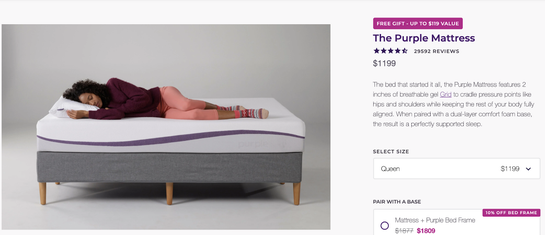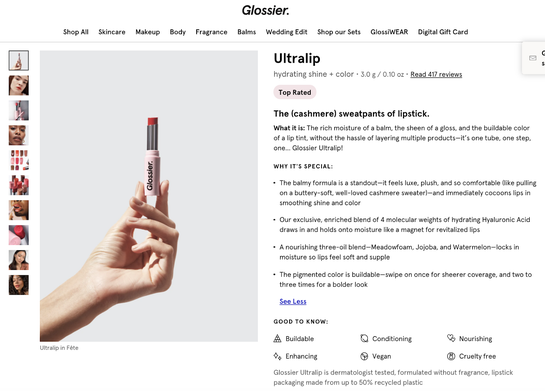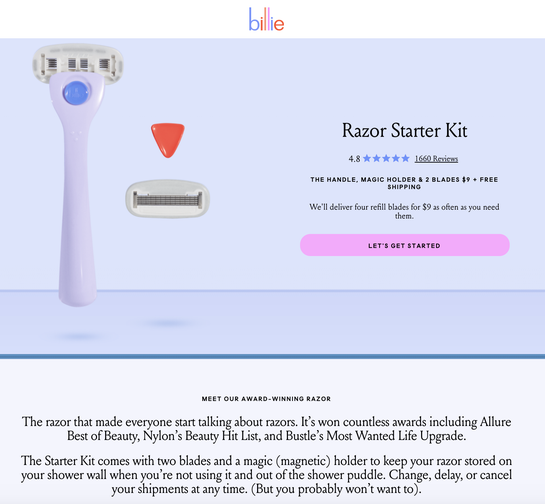Tips to Create Product Videos for Marketing
There are many types of product videos for marketing. No matter what type you're working on, it's important to make sure that your video is compelling.
Read More
Everyone knows the importance of writing compelling and persuasive product descriptions. However, much to the chagrin of entrepreneurs, marketers, and copywriters everywhere, we are susceptible to one common mistake: Writing product descriptions that simply explain your products and little else.
You may ask: Isn’t that the point? Well, yes... and no. Great product descriptions don’t just inform shoppers on what your items are — they elevate your product pages by selling the product through storytelling.
Here’s how to write product descriptions that persuade, captivate, and sell, plus other helpful tips and tricks.
A product description is the copy under your product name that describes the item’s attributes, key features, and specifications. When done right, it explains why the item is worth purchasing in a way that makes the act of purchasing irresistible while also infusing target keywords to boost SEO.
When you first put your pen to the page, it can be easy to fall into the trap of writing for a huge faceless crowd of buyers. Though it can make the creative process more straightforward, your descriptions will likely end up bland, dispassionate, and wishy-washy.
Instead, clearly address your target shopper — and not just by using second-person mentions of “you.” Develop a firm understanding of who your audience is. (For a refresher on customer profiles and personas, check out this guide.) By knowing their needs, desires, and wants, you can then write as though you’re conversing with them one-on-one in a way that resonates more deeply.
It’s not unusual for marketers to get so excited about their brand that they forget how shoppers don’t share that same familiarity with the products. Most customers have no clue why they should care about certain product features — all they want to know is what’s in it for them.
Purple Mattress describes its “breathable gel Grid” technology early on and quickly follows up with what it means for shoppers: “perfectly supported sleep.”
As a result, it’s important to save the technical specs for later in your product descriptions (these target keywords will also help you with your SEO). Instead, be straightforward at the get-go about how your product will solve shoppers’ pain points or improve their lives.
It may be a design principle from the 1960s, but KISS — the acronym for “keep it simple, stupid” — is highly applicable to all things ecommerce, including product descriptions.
Many shoppers don’t have the patience to read lengthy paragraphs chock-full of terms they don’t understand. They also don’t want to read descriptions filled with fluffy language and missing specific attributes — for instance, phrases like “high product quality.”
So, how to write product descriptions that are clear, direct, and specific? Stick to benefits, technical details, and social proof.
Everyone says their product is “the best in the market” or “the easiest to use,” but when you have nothing to back that up with, it can come off as shady marketing.
When you use superlatives — which you should be doing! — make sure to provide proper context and proof. For example, you can cite an award that you’ve received from a famous publication, or you can refer to a patent that your product has.
When you’re online shopping, you rely on product photos and descriptions for a sense of what a product feels, tastes, looks, smells, or sounds like.
There’s a copywriting trick that helps: Appeal to shoppers’ imagination by leveraging sensory verbs and adjectives. Start a sentence with the word “imagine,” then write a short paragraph on how shoppers will feel once they own and use your product. You can use this as the basis for your product description.
Glossier’s product descriptions are packed with sensory words — “buttery-soft,” “cocoons,” and “nourishing” are just one of the many used to describe this lipstick.
While you don’t want to inundate your product description with adjectives, vivid ones that pack a punch can go a long way in your storytelling.
If you’re still feeling stuck, we have another easy trick to get your creative juices flowing: Write a mini-story. Include information about:
This story can serve as the lead-in to product benefits and testimonials.
Testimonials from your top customers are the secret sauce marketers don’t always realize they have — a high-praising honest opinion can quickly turn a “meh” product description into a convincing one. Just think about the number of times you were compelled to buy a product with the highest number of positive reviews. Word-of-mouth works!
Social proof doesn’t have to just exist in the reviews section, either. You can feature your best five-star reviews in the product description or even quote celebrities or publications that have tested your product. Another idea is to add “best-selling product” or “fastest product to sell out” in your product description, citing any accolades or awards your product has won.
Direct-to-consumer (D2C) brand Billie kicks off its razor starter kit’s product page with a huge dose of social proof via a list of all the awards it has won.
Nobody enjoys reading long chunks of text. Instead, keep things as easily digestible as possible (this applies to all marketing-related copy, from emails to website homepages).
For product descriptions, this means:
With these eight tactics, you’ll become a pro who knows how to write product descriptions that attract and convert. Most importantly, write with a passion for your products and brand — trust us, it’ll show.
Looking to learn more about optimizing product pages? Here's your guide to product photography.
Last updated on December 9th, 2022.


